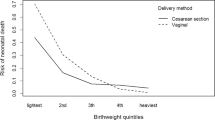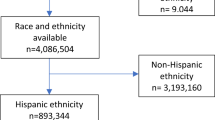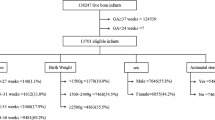Abstract
Objective:
To estimate the burden of prematurity, determine gestational age (GA)-specific neonatal mortality rates and provide recommendations for country programs.
Study Design:
Prospective data on pregnancy, childbirth, GA and newborn mortality collected by trained community health workers from 10 585 mother–newborn pairs in a community-based study.
Result:
A total of 19.4% of newborn infants were preterm; 13.5% were late preterm (born between 34 and 36 weeks of gestation), 3.3% were moderate preterm (born at 32 to 33 weeks) and 2.6% were extremely preterm (born at 28 to 31 weeks of gestation). Preterm babies experienced 46% of all neonatal deaths; 40% of preterm deaths were in late preterm, 20% in moderate preterm and 40% in very preterm infants. The population attributable fraction of neonatal mortality in premature babies was 0.16 for very preterm, 0.07 for moderately preterm and 0.10 for late preterm.
Conclusion:
In settings where the majority of births and newborn deaths occur at home and successful referral is a challenge, moderate and late preterm babies may be an important target group for home-based or first-level facility-based management.
This is a preview of subscription content, access via your institution
Access options
Subscribe to this journal
Receive 12 print issues and online access
$259.00 per year
only $21.58 per issue
Buy this article
- Purchase on Springer Link
- Instant access to full article PDF
Prices may be subject to local taxes which are calculated during checkout

Similar content being viewed by others
References
World Health Organization. Coverage of Maternity Care. A Listing of Available Information. World Health Organization: Geneva, 1997 WHO/RHT/MSM/96, pp 28.
Lawn JE, Gravett MG, Nunes TM, Rubens CE, Stanton C . Global report on preterm birth and stillbirth (1 of 7): definitions, description of the burden and opportunities to improve data. BMC Pregnancy Childbirth 2010; 10 (Suppl 1): S1.
Liu L, Johnson HL, Cousens S, Perin J, Scott S, Lawn JE et al. Global, regional, and national causes of child mortality: an updated systematic analysis for 2010 with time trends since 2000. Lancet 2012; 379 (9832): 2151–2161.
Myers E, Ment LR . Long-term outcome of preterm infants and the role of neuroimaging. Clin Perinatol 2009; 36 (4): 773–789.
Chang HH, Larson J, Blencowe H, Spong CY, Howson CP, Cairns-Smith S et al. Preventing preterm births: analysis of trends and potential reductions with interventions in 39 countries with very high human development index. Lancet 2013; 381 (9862): 223–234.
Blencowe H, Cousens S, Oestergaard MZ, Chou D, Moller AB, Narwal R et al. National, regional, and worldwide estimates of preterm birth rates in the year 2010 with time trends since 1990 for selected countries: a systematic analysis and implications. Lancet 2012; 379 (9832): 2162–2172.
Romero R, Espinoza J, Goncalves LF, Kusanovic JP, Friel LA, Nien JK . Inflammation in preterm and term labour and delivery. Semin Fetal Neonatal Med 2006; 11 (5): 317–326.
Goldenberg RL, Culhane JF, Iams JD, Romero R . Epidemiology and causes of preterm birth. Lancet 2008; 371 (9606): 75–84.
Gonzalez R, Merialdi M, Lincetto O, Lauer J, Becerra C, Castro R et al. Reduction in neonatal mortality in Chile between 1990 and 2000. Pediatrics 2006; 117 (5): e949–e954.
Iams JD, Goldenberg RL, Mercer BM, Moawad A, Thom E, Meis PJ et al. The Preterm Prediction Study: recurrence risk of spontaneous preterm birth. National Institute of Child Health and Human Development Maternal-Fetal Medicine Units Network. Am J Obstet Gynecol 1998; 178 (5): 1035–1040.
Kramer MS, Barros FC, Demissie K, Liu S, Kiely J, Joseph KS . Does reducing infant mortality depend on preventing low birthweight? An analysis of temporal trends in the Americas. Paediatr Perinat Epidemiol 2005; 19 (6): 445–451.
Bhutta ZA, Darmstadt GL, Hasan BS, Haws RA . Community-based interventions for improving perinatal and neonatal health outcomes in developing countries: a review of the evidence. Pediatrics 2005; 115 (2 Suppl): 519–617.
Martines J, Paul VK, Bhutta ZA, Koblinsky M, Soucat A, Walker N et al. Neonatal survival: a call for action. Lancet 2005; 365 (9465): 1189–1197.
Bang AT, Reddy HM, Bang RA, Deshmukh MD . Why do neonates die in rural Gadchiroli, India? (Part II): estimating population attributable risks and contribution of multiple morbidities for identifying a strategy to prevent deaths. J Perinatol 2005; 25 (Suppl 1): S35–S43.
Bang AT, Baitule SB, Reddy HM, Deshmukh MD, Bang RA . Low birth weight and preterm neonates: can they be managed at home by mother and a trained village health worker? J Perinatol 2005; 25 (Suppl 1): S72–S81.
Baqui AH, El-Arifeen S, Darmstadt GL, Ahmed S, Williams E, Seraji H et al. Effect of community-based newborn-care intervention package implemented through two service-delivery strategies in Sylhet district, Bangladesh: a cluster-randomised controlled trial. Lancet 2008; 371 (9628): 1936–1944.
Baqui AH, Arifeen SE, Williams E, Ahmed S, Mannan I, Rahman S et al. Effectiveness of home-based management of newborn infections by community health workers in rural Bangaldesh. Pediatr Infect Dis J 2009; 28 (4): 304–310.
Rosner B . Fundamentals of Biostatistics 6th edn. Duxbury: Belmont, CA, 2006.
Rockhill B, Newman B, Weinberg C . Use and misuse of population attributable fractions. Am J Public Health 1998; 88 (1): 15–19.
Black RE, Cousens S, Johnson HL, Lawn JE, Rudan I, Bassani DG et al. Global, regional, and national causes of child mortality in 2008: a systematic analysis. Lancet 2010; 375 (9730): 1969–1987.
Beck S, Wojdyla D, Say L, Betran AP, Merialdi M, Requejo JH et al. The worldwide incidence of preterm birth: a systematic review of maternal mortality and morbidity. Bull World Health Organ 2010; 88 (1): 1–80.
Mamun AA, Padmadas SS, Khatun M . Maternal health during pregnancy and perinatal mortality in Bangladesh: evidence from a large-scale community-based clinical trial. Paediatr Perinat Epidemiol 2006; 20 (6): 482–490.
Osendarp SJ, van Raaij JM, Arifeen SE, Wahed M, Baqui AH, Fuchs GJ . A randomized, placebo-controlled trial of the effect of zinc supplementation during pregnancy on pregnancy outcome in Bangladeshi urban poor. Am J Clin Nutr 2000; 71 (1): 114–119.
American Academy of Pediatrics Committee on F, Newborn. Hospital discharge of the high-risk neonate. Pediatrics 2008; 122 (5): 1119–1126.
World Health Organization Deptartment of Child and Adolescent Health and Development UNICEF. Home Visits for the Newborn Child: a Strategy to Improve survival. WHO/UNICEF Joint Statement. World Health Organization: Geneva, 2009 pp 7.
Borulkar PD, Borulkar SP, Dhole RK, Daga SR . Special care for newborns at a community hospital: a 5-year experience. Trop Doc 1998; 28 (4): 201–203.
Daga SR, Chandrashekhar L, Pol PP, Patole S . Appropriate technology in keeping babies warm in India. AnnTrop Paediatr 1986; 6 (1): 23–25.
Narayanan I . Care of the low birthweight infant in developing countries. Ann Trop Paediatr 1986; 6 (1): 11–15.
McCall EM, Alderdice F, Halliday HL, Jenkins JG, Vohra S . Interventions to prevent hypothermia at birth in preterm and/or low birthweight infants. Cochrane Database Syst Rev 2010; 3: CD004210.
Kumar V, Mohanty S, Kumar A, Misra RP, Santosham M, Awasthi S et al. Effect of community-based behaviour change management on neonatal mortality in Shivgarh, Uttar Pradesh, India: a cluster-randomised controlled trial. Lancet 2008; 372 (9644): 1151–1162.
Mannan I, Rahman SM, Sania A, Seraji HR, Arifeen SE, Winch PJ et al. Can early postpartum home visits by trained community health workers improve breastfeeding of newborns? J Perinatol 2008; 28 (9): 632–640.
Bang AT, Bang RA, Baitule SB, Reddy MH, Deshmukh MD . Effect of home-based neonatal care and management of sepsis on neonatal mortality: field trial in rural India. Lancet 1999; 354 (9194): 1955–1961.
Bang AT, Bang RA, Baitule SB, Reddy HM, Deshmukh MD . Management of birth asphyxia in home deliveries in rural Gadchiroli: the effect of two types of birth attendants and of resuscitating with mouth-to-mouth, tube-mask or bag-mask. J Perinatol 2005; 25 (Suppl 1): S82–S91.
Gray PH, Flenady V . Cot-nursing versus incubator care for preterm infants. Cochrane Database Syst Rev 2003; (1): CD003062.
Lawn JE, Mwansa-Kambafwile J, Horta BL, Barros FC, Cousens S . 'Kangaroo mother care' to prevent neonatal deaths due to preterm birth complications. Int J Epidemiol 2010; 39 ((Suppl 1): i144–i154.
Gilbert WM, Nesbitt TS, Danielsen B . The cost of prematurity: quantification by gestational age and birth weight. Obstet Gynecol 2003; 102 (3): 488–492.
Rubaltelli FF, Bonafe L, Tangucci M, Spagnolo A, Dani C . Epidemiology of neonatal acute respiratory disorders. A multicenter study on incidence and fatality rates of neonatal acute respiratory disorders according to gestational age, maternal age, pregnancy complications and type of delivery. Italian Group of Neonatal Pneumology. Biol Neonate 1998; 74 (1): 7–15.
Kaushik SL, Parmar VR, Grover N, Kaushik R . Neonatal mortality rate: relationship to birth weight and gestational age. Indian J Pediatr 1998; 65 (3): 429–433.
Kuti O, Owa JA . Gestational age-specific neonatal mortality among preterm singleton births in a Nigerian tertiary institution. Int J Gynaecol Obstet 2003; 80 (3): 319–320.
Lynch CD, Zhang J . The research implications of the selection of a gestational age estimation method. Paediatr Perinatal Epidemiol 2007; 21 (s2): 86–96.
Wegienka G, Baird DD . A comparison of recalled date of last menstrual period with prospectively recorded dates. J Women's Health 2005; 14 (3): 248–252.
Savitz DA, Terry JW Jr., Dole N, Thorp JM Jr, Siega-Riz AM, Herring AH . Comparison of pregnancy dating by last menstrual period, ultrasound scanning, and their combination. Am J Obstet Gynecol 2002; 187 (6): 1660–1666.
Rosenberg RE, Ahmed AS, Ahmed S, Saha SK, Chowdhury MA, Black RE et al. Determining gestational age in a low-resource setting: validity of last menstrual period. J Health Popul Nutr 2009; 27 (3): 332–338.
Hoffman CS, Messer LC, Mendola P, Savitz DA, Herring AH, Hartmann KE . Comparison of gestational age at birth based on last menstrual period and ultrasound during the first trimester. Paediatr Perinat Epidemiol 2008; 22 (6): 587–596.
Yang H, Kramer MS, Platt RW, Blondel B, Bréart G, Morin I et al. How does early ultrasound scan estimation of gestational age lead to higher rates of preterm birth? Am J Obstet Gynecol 2002; 186 (3): 433–437.
Jehan I, Zaidi S, Rizvi S, Mobeen N, McClure EM, Munoz B et al. Dating gestational age by last menstrual period, symphysis-fundal height, and ultrasound in urban Pakistan. Int J Gynaecol Obstet 2010; 110 (3): 231–234.
Shaaban OM, Hassen SG, Nour SA, Kames MA, Yones EM . Emergency contraceptive pills as a backup for lactational amenorrhea method (LAM) of contraception: a randomized controlled trial. Contraception 2013; 87 (3): 363–369.
Acknowledgements
This research was funded by the United States Agency for International Development (USAID), through cooperative agreements with the Johns Hopkins Bloomberg School of Public Health and the International Centre for Diarrhoeal Disease Research, Bangladesh (ICDDR,B), and by the Saving Newborn Lives Program of Save the Children-US through a grant from the Bill and Melinda Gates Foundation. The study was conducted by the Projahnmo study group in Bangladesh. Projhanmo is a partnership of the ICDDR,B; the Bangladesh government’s Ministry of Health and Family Welfare; Bangladeshi nongovernmental organizations, including Shimantik, Save the Children-US, Dhaka Shishu Hospital and the Institute of Child and Mother Health and the Johns Hopkins Bloomberg School of Public Health. We thank the members of the Projahnmo study team and colleagues at the Bangladesh Ministry of Health and Family Welfare at the sub-district, district and central levels for their valuable help and advice. We thank the many individuals in Sylhet district who gave their time generously as well as Projahnmo field and data management staff who worked tirelessly.
Author information
Authors and Affiliations
Corresponding author
Ethics declarations
Competing interests
The authors declare no conflict of interest.
Rights and permissions
About this article
Cite this article
Baqui, A., Rosen, H., Lee, A. et al. Preterm birth and neonatal mortality in a rural Bangladeshi cohort: implications for health programs. J Perinatol 33, 977–981 (2013). https://doi.org/10.1038/jp.2013.91
Received:
Revised:
Accepted:
Published:
Issue Date:
DOI: https://doi.org/10.1038/jp.2013.91
Keywords
This article is cited by
-
Perception and experiences of adolescent mothers and communities in caring for their preterm babies: findings from an in-depth study in rural Bangladesh
BMC Pregnancy and Childbirth (2024)
-
Maternal exposure to multiple mycotoxins and adverse pregnancy outcomes: a prospective cohort study in rural Bangladesh
Archives of Toxicology (2023)
-
Estimating cyclone vulnerability and its linkages with child mortality trajectories along the Bay of Bengal coast of India: a geospatial approach
GeoJournal (2022)
-
Maternal short stature and under-weight status are independent risk factors for preterm birth and small for gestational age in rural Bangladesh
European Journal of Clinical Nutrition (2019)
-
Umbilical Serum Copper Status and Neonatal Birth Outcomes: a Prospective Cohort Study
Biological Trace Element Research (2018)



